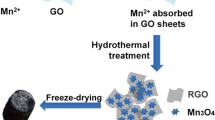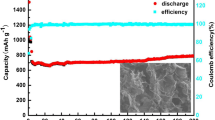Abstract
A three-dimensional nanostructured graphene oxide–Mn3O4 hybrid was synthesized by a coprecipitation method and used as an anode material of lithium ion batteries, which reached an initial specific capacity of 1400 mA h/g. This method was developed to simplify the process of fabricating uniform composite nanomaterials for abundant applications. In this work, Mn3O4 particles were coordinately distributed on the surface of reduced graphene oxide nanosheets to avoid detrimental stacking of graphene layers by forming 3D nanostructures, as characterized by a scanning electron microscope. As demonstrated by the in situ observation of a scanning probe microscope, severe pulverization of Mn3O4 particles during charge/discharge processing was significantly abstained when graphene layers constrained swelling and shrinkage. The as-prepared graphene–Mn3O4 nanomaterials exhibited a large specific capacity of 949 mA h/g, high-rechargeable efficiency of ∼98%, and exceptional cyclic stability. After 100 constant-current charging/discharging cycles at 100 mA/g, the specific capacity remained at 792 mA h/g with a coulombic efficiency of 98.1%. Furthermore, the coprecipitation method proposed in this work provides a strategy to fabricate other nanostructured composites for different kinds of applications.







Similar content being viewed by others
References
W. Chen, Z. Zhu, S. Li, C. Chen, and L. Yan: Efficient preparation of highly hydrogenated graphene and its application as a high-performance anode material for lithium ion batteries. Nanoscale 4, 2124 (2012).
Z. Bai, N. Fan, C. Sun, Z. Ju, C. Guo, J. Yang, and Y. Qian: Facile synthesis of loaf-like ZnMn2O4 nanorods and their excellent performance in Li-ion batteries. Nanoscale 5, 2442 (2013).
P. Verma, P. Maire, and P. Novak: A review of the features and analyses of the solid electrolyte interphase in Li-ion batteries. Electrochim. Acta 55, 6332 (2010).
A. Bello, O. Fashedemi, M. Fabiane, J. Lekitima, K. Ozoemena, and N. Manyala: Microwave assisted synthesis of MnO2 on nickel foam-graphene for electrochemical capacitor. Electrochim. Acta 114, 48 (2013).
K. Shi and I. Zhitomirsky: Fabrication of polypyrrole-coated carbon nanotubes using oxidant-surfactant nanocrystals for supercapacitor electrodes with high mass loading and enhanced performance. ACS Appl. Mater. Interfaces 5, 13161 (2013).
D. Bhattacharjya, M. Kim, T. Bae, and J. Yu: High performance supercapacitor prepared from hollow mesoporous carbon capsules with hierarchical nanoarchitecture. J. Power Sources 244, 799 (2013).
M. Ghasemi, W. Daud, S. Hassan, S. Oh, M. Ismail, M. Rahimnejad, and J. Jahim: Nano-structured carbon as electrode material in microbial fuel cells: A comprehensive review. J. Alloys Compd. 580, 245 (2013).
H. Wang, B. Kakade, T. Tamaki, and T. Yamaguchi: Synthesis of 3D graphite oxide-exfoliated carbon nanotube carbon composite and its application as catalyst support for fuel cells. J. Power Sources 260, 338 (2014).
Y. Chen, C. Su, T. Zheng, and Z. Shao: Coke-free direct formic acid solid oxide fuel cells operating at intermediate temperatures. J. Power Sources 220, 147 (2012).
U. Yun, J. Lee, S. Lee, T. Lim, S. Park, R. Song, and D. Shin: Fabrication and operation of tubular segmented-in-series (SIS) solid oxide fuel cells (SOFC). Fuel Cells 12, 1099 (2012).
M. Safari and C. Delacourt: Aging of a commercial graphite/LiFePO4 cell. J. Electrochem. Soc. 158, A1123 (2011).
C. Banks and R. Compton: New electrodes for old: From carbon nanotubes to edge plane pyrolytic graphite. Analyst 131, 15 (2006).
Y. Mai, S. Shi, D. Zhang, Y. Lum, C. Gu, and J. Tu: NiO-graphene hybrid as an anode material for lithium ion batteries. J. Power Sources 204, 155 (2012).
Y. Mai, D. Zhang, Y. Qiao, C. Gu, X. Wang, and J. Tu: MnO/reduced graphene oxide sheet hybrid as an anode for Li-ion batteries with enhanced lithium storage performance. J. Power Sources 216, 201 (2012).
H. Wang, L. Cui, Y. Yang, H. Casalongue, J. Robinson, Y. Liang, Y. Cui, and H. Dai: Mn3O4-graphene hybrid as a high-capacity anode material for lithium ion batteries. J. Am. Chem. Soc. 132, 13978 (2010).
N. Lavoie, P. Malenfant, F. Courtel, Y. Abu-Lebdeh, and I. Davidson: High gravimetric capacity and long cycle life in Mn3O4/graphene platelet/LiCMC composite lithium-ion battery anodes. J. Power Sources 213, 249 (2012).
K. Zhang, P. Han, L. Gu, L. Zhang, Z. Liu, Q. Kong, C. Zhang, S. Dong, Z. Zhang, J. Yao, H. Xu, G. Cui, and L. Chen: Synthesis of nitrogen-doped MnO/graphene nanosheets hybrid material for lithium ion batteries. ACS Appl. Mater. Interfaces 4, 658 (2012).
B. Li, H. Cao, J. Shao, G. Li, M. Qu, and G. Yin: Co3O4@graphene composites as anode materials for high-performance lithium ion batteries. Inorg. Chem. 50, 1628 (2011).
G. Kim, I. Nam, N. Kim, J. Park, S. Park, and J. Yi: A synthesis of graphene/Co3O4 thin films for lithium ion battery anodes by coelectrodeposition. Electrochem. Commun. 22, 93 (2012).
A. Yu, H. Park, A. Davies, D. Higgins, Z. Chen, and X. Xiao: Free-standing layer-by-layer hybrid thin film of graphene-MnO2 nanotube as anode for lithium ion batteries. J. Phys. Chem. Lett. 2, 1855 (2011).
P. Lian, X. Zhu, S. Liang, Z. Li, W. Yang, and H. Wang: Large reversible capacity of high quality graphene sheets as an anode material for lithium-ion batteries. Electrochim. Acta 55, 3909 (2010).
X. Huang, Z. Zeng, Z. Fan, J. Liu, and H. Zhang: Graphene-based electrodes. Adv. Mater. 24, 5979 (2012).
S. Chattopadhyay, A. Lipson, H. Karmel, J. Emery, T. Fister, P. Fenter, M. Hersam, and M. Bedzyk: In situ x-ray study of the solid electrolyte interphase (SEI) formation on graphene as a model Li-ion battery anode. Chem. Mater. 24, 3038 (2012).
H. Xiang, Z. Li, K. Xie, J. Jiang, J. Chen, P. Lian, J. Wu, Y. Yu, and H. Wang: Graphene sheets as anode materials for Li-ion batteries: Preparation, structure, electrochemical properties, and mechanism for lithium storage. R. Soc. Chem. Adv. 2, 6792 (2012).
Z. Wu, W. Ren, L. Xu, F. Li, and H. Cheng: Doped graphene sheets as anode materials with superhigh rate and large capacity for lithium ion batteries. ACS Nano 5, 5463 (2011).
C. Zhao, Q. Wang, Y. Yang, B. Zhang, and X. Zhang: Self-assembled manganese oxide structures through direct oxidation. Appl. Surf. Sci. 263, 397 (2012).
X. Sun, Y. Xu, P. Ding, G. Chen, X. Zheng, R. Zhang, and L. Li: The composite sphere of manganese oxide and carbon nanotubes as a prospective anode material for lithium-ion batteries. J. Power Sources 255, 163 (2014).
R. Lee, Y. Lin, Y. Weng, H. Pan, J. Lee, and N. Wu: Synthesis of high-performance MnOx/carbon composite as lithium-ion battery anode by a facile co-precipitation method: Effects of oxygen stoichiometry and carbon morphology. J. Power Sources 253, 373 (2014).
S. Luo, H. Wu, Y. Wu, K. Jiang, J. Wang, and S. Fan: Mn3O4 nanoparticles anchored on continuous carbon nanotube network as superior anodes for lithium ion batteries. J. Power Sources 249, 464 (2014).
C. Kang, I. Lahiri, R. Baskaran, W. Kim, Y. Sun, and W. Choi: 3-dimensional carbon nanotube for Li-ion battery anode. J. Power Sources 219, 364 (2012).
N. Kaskhedikar and J. Maier: Lithium storage in carbon nanostructures. Adv. Mater. 21, 2664 (2009).
K. Zhong, X. Xia, B. Zhang, H. Li, Z. Wang, and L. Chen: MnO powder as anode active materials for lithium ion batteries. J. Power Sources 195, 3300 (2010).
M. Kawakubo, Y. Takeda, O. Yamamoto, and N. Imanishi: High capacity carbon anode for dry polymer lithium-ion batteries. J. Power Sources 226, 187 (2013).
Author information
Authors and Affiliations
Corresponding author
Rights and permissions
About this article
Cite this article
Wang, Y. Coprecipitated 3D nanostructured graphene oxide–Mn3O4 hybrid as anode of lithium-ion batteries. Journal of Materials Research 30, 484–492 (2015). https://doi.org/10.1557/jmr.2014.394
Received:
Accepted:
Published:
Issue Date:
DOI: https://doi.org/10.1557/jmr.2014.394




